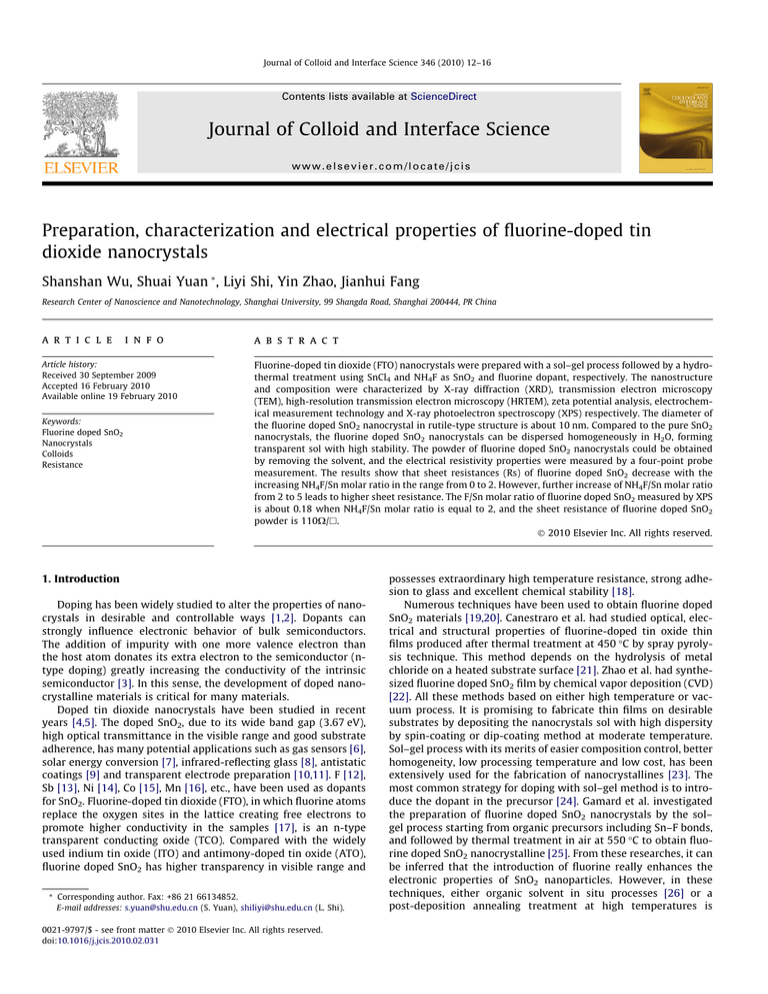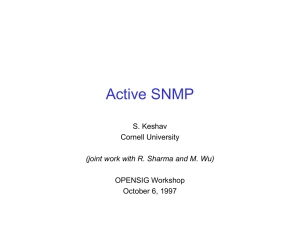
Journal of Colloid and Interface Science 346 (2010) 12–16
Contents lists available at ScienceDirect
Journal of Colloid and Interface Science
www.elsevier.com/locate/jcis
Preparation, characterization and electrical properties of fluorine-doped tin
dioxide nanocrystals
Shanshan Wu, Shuai Yuan *, Liyi Shi, Yin Zhao, Jianhui Fang
Research Center of Nanoscience and Nanotechnology, Shanghai University, 99 Shangda Road, Shanghai 200444, PR China
a r t i c l e
i n f o
Article history:
Received 30 September 2009
Accepted 16 February 2010
Available online 19 February 2010
Keywords:
Fluorine doped SnO2
Nanocrystals
Colloids
Resistance
a b s t r a c t
Fluorine-doped tin dioxide (FTO) nanocrystals were prepared with a sol–gel process followed by a hydrothermal treatment using SnCl4 and NH4F as SnO2 and fluorine dopant, respectively. The nanostructure
and composition were characterized by X-ray diffraction (XRD), transmission electron microscopy
(TEM), high-resolution transmission electron microscopy (HRTEM), zeta potential analysis, electrochemical measurement technology and X-ray photoelectron spectroscopy (XPS) respectively. The diameter of
the fluorine doped SnO2 nanocrystal in rutile-type structure is about 10 nm. Compared to the pure SnO2
nanocrystals, the fluorine doped SnO2 nanocrystals can be dispersed homogeneously in H2O, forming
transparent sol with high stability. The powder of fluorine doped SnO2 nanocrystals could be obtained
by removing the solvent, and the electrical resistivity properties were measured by a four-point probe
measurement. The results show that sheet resistances (Rs) of fluorine doped SnO2 decrease with the
increasing NH4F/Sn molar ratio in the range from 0 to 2. However, further increase of NH4F/Sn molar ratio
from 2 to 5 leads to higher sheet resistance. The F/Sn molar ratio of fluorine doped SnO2 measured by XPS
is about 0.18 when NH4F/Sn molar ratio is equal to 2, and the sheet resistance of fluorine doped SnO2
powder is 110X/h.
Ó 2010 Elsevier Inc. All rights reserved.
1. Introduction
Doping has been widely studied to alter the properties of nanocrystals in desirable and controllable ways [1,2]. Dopants can
strongly influence electronic behavior of bulk semiconductors.
The addition of impurity with one more valence electron than
the host atom donates its extra electron to the semiconductor (ntype doping) greatly increasing the conductivity of the intrinsic
semiconductor [3]. In this sense, the development of doped nanocrystalline materials is critical for many materials.
Doped tin dioxide nanocrystals have been studied in recent
years [4,5]. The doped SnO2, due to its wide band gap (3.67 eV),
high optical transmittance in the visible range and good substrate
adherence, has many potential applications such as gas sensors [6],
solar energy conversion [7], infrared-reflecting glass [8], antistatic
coatings [9] and transparent electrode preparation [10,11]. F [12],
Sb [13], Ni [14], Co [15], Mn [16], etc., have been used as dopants
for SnO2. Fluorine-doped tin dioxide (FTO), in which fluorine atoms
replace the oxygen sites in the lattice creating free electrons to
promote higher conductivity in the samples [17], is an n-type
transparent conducting oxide (TCO). Compared with the widely
used indium tin oxide (ITO) and antimony-doped tin oxide (ATO),
fluorine doped SnO2 has higher transparency in visible range and
* Corresponding author. Fax: +86 21 66134852.
E-mail addresses: s.yuan@shu.edu.cn (S. Yuan), shiliyi@shu.edu.cn (L. Shi).
0021-9797/$ - see front matter Ó 2010 Elsevier Inc. All rights reserved.
doi:10.1016/j.jcis.2010.02.031
possesses extraordinary high temperature resistance, strong adhesion to glass and excellent chemical stability [18].
Numerous techniques have been used to obtain fluorine doped
SnO2 materials [19,20]. Canestraro et al. had studied optical, electrical and structural properties of fluorine-doped tin oxide thin
films produced after thermal treatment at 450 °C by spray pyrolysis technique. This method depends on the hydrolysis of metal
chloride on a heated substrate surface [21]. Zhao et al. had synthesized fluorine doped SnO2 film by chemical vapor deposition (CVD)
[22]. All these methods based on either high temperature or vacuum process. It is promising to fabricate thin films on desirable
substrates by depositing the nanocrystals sol with high dispersity
by spin-coating or dip-coating method at moderate temperature.
Sol–gel process with its merits of easier composition control, better
homogeneity, low processing temperature and low cost, has been
extensively used for the fabrication of nanocrystallines [23]. The
most common strategy for doping with sol–gel method is to introduce the dopant in the precursor [24]. Gamard et al. investigated
the preparation of fluorine doped SnO2 nanocrystals by the sol–
gel process starting from organic precursors including Sn–F bonds,
and followed by thermal treatment in air at 550 °C to obtain fluorine doped SnO2 nanocrystalline [25]. From these researches, it can
be inferred that the introduction of fluorine really enhances the
electronic properties of SnO2 nanoparticles. However, in these
techniques, either organic solvent in situ processes [26] or a
post-deposition annealing treatment at high temperatures is
S. Wu et al. / Journal of Colloid and Interface Science 346 (2010) 12–16
indispensable [27]. Therefore, the synthesis of highly crystallized
fluorine doped SnO2 with dispersity through a facile method is still
a challenge.
Hydrothermal method has been applied to synthesize nanocrystals at relatively low reaction temperatures [28]. Dopant can
be introduced into the nanocrystalline in hydrothermal treatment.
Zhang et al. used this method to prepare antimony-doped tin oxide
(ATO) nanoparticles [29]. To the best of our knowledge, few works
have been devoted to the synthesis of FTO nanocrystals by introducing fluorine in hydrothermal process. Herein, we describe an
approach to synthesize fluorine doped SnO2 nanoparticles by a
process introducing fluorine in the hydrothermal condition.
In this paper, we synthesized fluorine doped and undoped SnO2
nanocrystalline with small grain size (10 nm) using hydrothermal treatment with and without the presence of NH4F in the solution, respectively. Using this method, the high crystallized fluorine
doped SnO2 nanoparticles were fabricated at low temperature
(<200 °C). Furthermore, the influences of the fluorine content on
the structure of SnO2 were investigated by transmission electron
microscopy (TEM), X-ray diffraction (XRD) and X-ray photoelectron spectroscopy (XPS). The stabilities of the sol and nanocrystalline’s electrical properties were determined by zeta potential
measurement and four-probe method, respectively.
2. Materials and methods
2.1. Materials
Tin tetrachloride (SnCl4), ammonium hydroxide (NH4OH), oxalic acid (H2C2O4) and ammonium fluoride (NH4F) were of analytical
grade without further purification (Sinopharm Chemical Reagent
Co., Ltd.); deionized water was used in the experiment.
2.2. Preparation of fluorine-doped tin dioxide nanocrystals
Fluorine doped SnO2 nanocrystals with diameter size ranging
from 9 to 13 nm were synthesized by sol–gel process followed by
a hydrothermal treatment. In a typical procedure, 6.67 g tin tetrachloride was dissolved in 31.0 ml deionized water, and aqueous
ammonia was added dropwise into the solution with stirring until
a pH value of 8 was reached. The precipitated was filtered, washed
with deionized water to remove impurity ions NHþ
4 and Cl . 2.68 g
oxalic acid was added into the obtained precipitation, the solution
was refluxed for 4 h at 100 °C. As the dopant, ammonium fluoride
was then added. The molar ratios between fluoride and tin precursor
was maintained around (0.5–5):1. Hydrothermal treatment was
then carried out in a 100 ml autoclave at 180 °C for 72 h. The product
was then centrifuged and washed with deionized water until the
impurity ions were absent. In these processes, a green sol was obtained after redispersion by ultrasonic treatment. Pure SnO2 was
synthesized according to the similar process without the addition
of ammonium fluoride in the hydrothermal treatment.
resistances were measured by the standard four-probe method
using a SDY-5 four-point probe meter. The surface composition
was examined by X-ray photoelectron spectroscopy (XPS; PHI5000C ESCA system) with Al Ka radiation. Fluorine content in tin
dioxide was studied by electrochemical measurement technologies
by a PF-1C (201) fluoride ion electrode instrument.
3. Results and discussion
3.1. Structural analysis
The XRD patterns of undoped and fluorine doped SnO2 materials are shown in Fig. 1. The XRD pattern of undoped SnO2 shows
the peaks at 2h equal to 26.6°, 33.8°, 37.9°, 51.8° and 65.9° corresponding to the (1 1 0), (1 0 1), (2 0 0), (2 1 1), and (3 0 1) planes
respectively, which match with diffraction of bulk tetragonal cassiterite (JCPDS 41-1445). With the increase of NH4F/Sn molar ratio,
a comparison of the (1 1 0) fraction peaks in the range of 2h = 20–
25° (Fig. 1) showed that the peak position of SnO2 shifted slightly
toward a lower 2h value, which maybe due to the substitution of
O2 by F ions [30–32]. The approximate crystallite sizes of the undoped and fluorine doped SnO2 were calculated by the Scherrer
formula and summarized in Table 1. The average grain sizes of
nanocrystals increase along with the increasing NH4F/Sn molar ratios from 0 to 2. However, further increase of NH4F/Sn molar ratio
will lead to smaller grain size. The ionic radius of F (1.33 Å) is
close to that of O2 (1.32 Å), so the doping process can take place
easily. The small change in the lattice volume is probably due to
the incorporation of fluorine ions into the oxygen ion sites [33].
From XRD patterns, none of the diffraction peaks corresponding
to SnF2 are found.
The morphologies, particle sizes and structures of the fluorine
doped and undoped SnO2 nanocrystalline were characterized by
the TEM and HRTEM. The fluorine doped SnO2 can be dispersed
homogeneously and the average diameters of the nanocrystallines
are about 10 nm (Fig. 2). These particle sizes of samples obtained
from TEM images are quite similar to those obtained from XRD
results. The HRTEM and the corresponding FFT patterns of undoped and fluorine doped SnO2 are shown in Fig. 3, confirming
the presence of highly crystalline rutile-type SnO2. The well-re-
2.3. Characterization
The as-prepared SnO2 sol was deposited in a copper-coated carbon grid for investigation by field emission transmission electron
microscopy (TEM, JEOL JEM-2010F) and high-resolution transmission electron microscopy (HRTEM) (JEOL 3010 ARP) microscope,
with the microscope operated at an acceleration voltage of
300 kV. The zeta potential of undoped and fluorine doped SnO2
were measured on a Zetasizer 3000HS (Malvern Instrument). The
powder samples were obtained after the sol was dried at 80 °C,
and then investigated by an X-ray diffraction (XRD) analysis with
a Rigaku D/MAX-RB diffractometer using Cu Ka radiation. Sheet
13
Fig. 1. XRD patterns of FTO with different NH4F/Sn molar ratio.
14
S. Wu et al. / Journal of Colloid and Interface Science 346 (2010) 12–16
Table 1
Characterization results of undoped and fluorine doped SnO2.
NH4F/Sna
D (nm)b
F/SnEMc
F/SnXPSd
f (mV)e
0
0.5
1.5
2
3
5
10.8
10.5
12.0
12.2
10.3
9.6
–
0.04
0.08
0.10
0.11
0.11
–
–
–
0.18
–
0.20
2.6
50.1
48.2
46.5
43.6
45.7
a
The molar ratio of initial NH4F/Sn in the autoclave before hydrothermal
treatment.
b
The diameter of nanocrystals calculated by Scherrer equation.
c
The molar ratio of F/Sn measured by electrochemical measurement technology.
d
The molar ratio of F/Sn measured by XPS.
e
The zeta potential of nanocrystal sol.
Fig. 3. HRTEM images of SnO2 nanocrystals: (a) undoped SnO2; (b) NH4F/Sn = 2; (c)
NH4F/Sn = 5; and (d) related FFT image.
Fig. 2. TEM images of SnO2 nanocrystals with doping ratio of: (a) undoped SnO2; (b)
NH4F/Sn = 0.5; (c) NH4F/Sn = 1.5; (d) NH4F/Sn = 2; (e) NH4F/Sn = 3; and (f) NH4F/
Sn = 5.
solved lattice fringes (Fig. 3a) show that the spacing is about
0.33 nm corresponding to the (1 1 0) plane of the rutile crystal
structure of the SnO2 nanocrystalline. The FFT pattern of Fig. 3d
(fluorine doped SnO2) corresponds to the (1 1 0) plane.
3.2. Surface chemistry of nanocrystals
Although XRD, TEM, HRTEM provide the information about the
structure of undoped and fluorine doped SnO2, further exploration
with XPS will give a more accurate understanding of the exact
chemical state of the elements. Fig. 4 shows the binding energies
of Sn3d5, F1s, and O1s of the samples measured by XPS. No XPS
peaks belonging to chlorine or nitrogen are observed, confirming
the complete remove of Cl and NHþ
4 by filtering and washing after
hydrothermal treatment. The binding energies obtained from XPS
analysis were corrected using the referencing C1s peak at 284.6 eV.
In Fig. 4B, the Sn3d5 binding energy peaks are observed at 487.0
and 495.2 eV, corresponding to the spin–orbit of Sn3d5/2 and
Sn3d3/2, which suggests that Sn in the samples only exists in a tetravalent-oxidation state [34]. As oxygen sites are occupied by doped
fluorine ions, the Sn3d peaks shift about 0.2 eV toward lower energies. O1s peaks (Fig. 5) of undoped and fluorine doped SnO2 are fitted through the AugerScan Demo software. The fitted binding
energies are located at 530.8 ± 0.2 eV and 532.0 ± 0.2 eV respectively, which indicates that at least two kinds of oxygen species
can be discerned. The peak with an O1s binding energy around
530.8 eV is attributed to oxygen in the SnO2 crystal lattice, which
corresponds to the Sn–O–Sn bonds. While the other peak positioned
at 532.0 eV should be ascribed to surface hydroxyl groups Sn–OH
and chemisorbed H2O molecules [35–37]. The area of peak belonging to surface hydroxyl becomes larger with higher fluorine content.
The F1s region (Fig. 4C) is observed at 684.0 eV, which corresponds to the F1s orbital. Martínez et al. reported fluorine signals
by spray pyrolysis, and they also reported that the fluorine doped
SnO2 was promoted by the formation of Sn–F bonds [38]. It is reasonable to assume that during the hydrothermal process, fluorine
ion reacts with Sn4+ and form either Sn–F or Sn–O–F bonds, as soon
as fluorine ion is released by NH4F in the solution [39]. The F/Sn
molar ratios in as-prepared fluorine doped SnO2 nanocrystalline
were also investigated by means of electrochemical measurement
methods. By comparing the fluorine contents measured by electrochemical measurement and XPS spectra (Table 1), it is found that
the more NH4F in the solution, the more Sn–F bonds forms due
to the substitution of oxygen by fluorine atoms. Compared with
electrochemical measurement results, the F/Sn molar ratios calculated from XPS results are higher indicating the concentrations of
doped F become lower with the increase of depth. The F/Sn molar
ratio measured by XPS of the samples with greater fluorine content
is 0.20 when NH4F/Sn is equal to 5.
3.3. Zeta potential
Zeta potential of undoped and fluorine doped SnO2 with different fluorine content are shown in Table 1. The pH value of each
S. Wu et al. / Journal of Colloid and Interface Science 346 (2010) 12–16
15
Fig. 4. (A) XPS spectra of undpoed and fluorine doped SnO2.; (B) Sn region; (C) F region. Samples a–c herein correspond to the: (a) undoped SnO2; (b) NH4F/Sn = 2; and (c)
NH4F/Sn = 5, respectively.
Fig. 5. O1s spectra fitted through the AugerScan Demo software: (a) Undoped SnO2; (b) NH4F/Sn = 2; and (c) NH4F/Sn = 5.
sample is fixed at 5.0. The stability of hydrosol depends on the zeta
potential value greatly. The hydrosol with absolute zeta potential
greater than 30.0 mV is a stable dispersion [40]. Zeta potential of
pure SnO2 is 2.6 mV, close to its isoelectric point (with the IEP in
the range of pH 4–5.5), which indicates that undoped SnO2 sol is
unstable. In fact, precipitate will emerge in 1 h for pure SnO2. In
contrast, fluorine doped SnO2 hydrosol can be stored at ambient
temperature for at least 1 week (Fig. 6). The positive zeta potential
of pure SnO2 maybe result from the equilibrium shifts to the right
side as follows:
Sn OH þ Hþ () Sn OHþ2
ð1Þ
Fluorine doping plays an important role on the stability of the
sol (Table 1). The zeta potentials of fluorine doped samples are
all negative, indicating a large number of negative charges on
nanocrystals surface. The replacement of O by F increases the density of electron distribution in the surface of SnO2 nanocrystals, and
results more hydroxyl groups (OH) on the particle surface, which
agrees well with the XPS analysis of the samples. The absolute zeta
potentials of all fluorine doped SnO2 are higher than 30.0 mV, indicating higher stability than the pure SnO2 sol.
Fig. 6. Photograph of undoped (left) and fluorine doped SnO2 hydrosol (NH4F/Sn
molar ratio is equal to 2).
3.4. Electrical properties
Under certain pressure (3 MPa), a given amount of power (0.5 g)
were compacted into a pallet (diameter of 10 mm, thickness of
4.2 mm). The sheet resistance was estimated by the as-palletized
samples. Fig. 7 shows the variation of the sheet resistance with
16
S. Wu et al. / Journal of Colloid and Interface Science 346 (2010) 12–16
(07XD14014); Shanghai Leading Academic Discipline Project
(S30107); Key Project of Chinese Ministry of Education (208182);
National High Technology Research and Development Program
(863 Program) of China (2007AA03Z335); International cooperation
fund of Shanghai Science and Technology Committee (0952070
9500); The Special Project for Nano-Science of Shanghai Science
and Technology Committee (08520704800, 0852nm01800).
References
Fig. 7. Sheet resistance of SnO2 powder doped with different NH4F/Sn molar ratio.
the different fluorine content for the SnO2 powder. In pure SnO2, as
the free carriers are supplied by the oxygen vacancies, the sheet
resistance is dependent on the oxygen defect of SnO2 grains. The
sheet resistance is found to decrease along with the increase of
the F/Sn molar ratios. One fluorine atom gives one free electron
when the F ion sits in the place of O2 anion, and the fluorine contributes free electrons to promote higher conductivity in fluorine
doped SnO2 as follows [25]:
2
xF þ xe þ Sn4þ O2 () Sn4þ O2
ð2xÞ Fx ½xe CB þ xO
ð2Þ
where [xe ]CB represents the concentration of electrons generated
in the conduction band and responsible for the conduction. Accompanying with the increasing F/Sn molar ratios, the sheet resistance
becomes smaller due to more free carriers in fluorine doped SnO2
come from both oxygen vacancies and fluorine-doping [17]. A minimum value of 110 X/h is obtained when NH4F/Sn molar ratio
equals to 2. Correlated with the XRD studies, there is also a significant negative correlation between the grain size and the sheet
resistance, which can be attributed to grain boundary scattering.
For higher fluorine content, the sheet resistance increased, this fact
can be attributed to the excess fluorine atoms which lie in the grain
boundary regions forming Sn–F bonds and cannot act favorably for
the growth of SnO2 nanocrystals [41].
4. Summary
Fluorine doped SnO2 (FTO) nanocrystals were successfully prepared with a sol–gel process followed by hydrothermal treatment.
XRD studies reveal that the products exhibit good crystallinity
with the cassiterite structure. The grain size of as-synthesized
SnO2 is calculated to be 9–13 nm through XRD and TEM patterns.
XPS analysis confirms the presence of Sn–F bonds in accordance
to the observed lattice expansion. Introduction of fluorine atoms
into the SnO2 lattice could improve the stability of SnO2 sol. The
change of sheet resistance of fluorine doped SnO2 is promoted by
the fluorine doping and oxygen vacancies, the minimum Rs is
110 X/h, which corresponding to the NH4F/Sn molar ratio is equal
to 2.
Acknowledgments
The authors acknowledge the supports of Academic Leader
Program of Shanghai Science and Technology Committee
[1] D.J. Norris, A.L. Efros, S.C. Erwin, Science 319 (2008) 1776.
[2] N. Pradhan, D. Goorskey, J. Thessing, X.G. Peng, J. Am. Chem. Soc. 127 (2005)
7586.
[3] C.G.V. Walle, Phys. Rev. Lett. 85 (2000) 012.
[4] A. Sadeh, S. Sladkevich, F. Gelman, P. Prikhodchenko, I. Baumberg, O. Berezin,
O. Lev, Anal. Chem. 79 (2007) 5188.
[5] T. Giannakopoulou, N. Todorova, C. Trapalis, T. Vaimakis, Mater. Lett. 61 (2007)
4474.
[6] T. Sahm, L. Mädler, A. Gurlo, N. Barsan, S.E. Pratsinis, U. Weimar, Sens.
Actuators, B 98 (2004) 148.
[7] S.I. Boiadjiev, G.H. Dobrikov, M.M.M. Rassovska, Thin Solid Films 515 (2007)
8465.
[8] L.R. Hou, C.Z. Yuan, Y. Peng, J. Hazard. Mater. 139 (2007) 310.
[9] Y.S. Cho, G.R. Yi, J.J. Hong, S.H. Jang, S.M. Yang, Thin Solid Films 515 (2006) 864.
[10] H. Cachet, A. Gamard, G. Campet, B. Jousseaume, T. Toupance, Thin Solid Films
388 (2001) 41.
[11] D.W. Sheel, H.M. Yates, P. Evans, U. Dagkaldiran, A. Gordijn, F. Finger, Z. Remes,
M. Vanecek, Thin Solid Films 517 (2009) 3061.
[12] H.W. Ha, K. Kim, M. de Borniol, T. Toupance, J. Solid State Chem. 179 (2006)
702.
[13] J. Ni, X. Zhao, X. Zheng, J. Zhao, B. Liu, Acta Mater. 57 (2009) 278.
[14] P.I. Archer, P.V. Radovanovic, S.M. Heald, D.R. Gamelin, J. Am. Chem. Soc. 127
(2005) 14479.
[15] Y.L. Zuo, S.H. Ge, Y.X. Zhao, X.Y. Zhou, Y.H. Xiao, L. Zhang, J. Appl. Phys. 104
(2008) 023905.
[16] F. Gu, S.F. Wang, M.K. Lü, G.J. Zhou, D. Xu, D.R. Yuan, J. Phys. Chem. B 108
(2004) 8119.
[17] H. Kim, R.C.Y. Auyeung, A. Piqué, Thin Solid Films 516 (2008) 5052.
[18] B. Russo, G.Z. Cao, Appl. Phys. A 90 (2008) 311.
[19] M. Adnane, H. Cachet, G. Folcher, S. Hamzaoui, Thin Solid Films 492 (2005)
240.
[20] A.V. Moholkar, S.M. Pawar, K.Y. Rajpure, C.H. Bhosale, Mater. Lett. 61 (2007)
3030.
[21] C.D. Canestraro, M.M. Oliveira, R. Valaski, M.V.S. da Silva, D.G.F. David, I. Pepe,
A.F. da Silva, L.S. Roman, C. Persson, Appl. Surf. Sci. 255 (2008) 1874.
[22] H.L. Zhao, Q.Y. Liu, Y.X. Cai, F.C. Zhang, Mater. Lett. 62 (2008) 1294.
[23] M. Niederberger, Acc. Chem. Res. 40 (2007) 793.
[24] T.J. Liu, Z.G. Jin, L.R. Feng, T. Wang, Appl. Surf. Sci. 254 (2008) 6547.
[25] A. Gamard, O. Babot, B. Jousseaume, M.C. Rascle, T. Toupance, G. Campet,
Chem. Mater. 12 (2000) 3419.
[26] K.C. Molloy, J.E. Stanley, Appl. Organomet. Chem. 23 (2009) 62.
[27] S.J. Ikhmayies, R.N. Ahmad-Bitar, Appl. Surf. Sci. 255 (2008) 2627.
[28] B.L. Cushing, V.L. Kolesnichenko, C. O’Connor, J. Chem. Rev. 104 (2004) 3893.
[29] J.R. Zhang, L. Gao, Mater. Chem. Phys. 87 (2004) 10.
[30] G.L. Huang, S.C. Zhang, T.G. Xu, Y.F. Zhu, Environ. Sci. Technol. 42 (2008) 8516.
[31] H.B. Fu, S.C. Zhang, T.G. Xu, Y.F. Zhu, J.M. Chen, Environ. Sci. Technol. 42 (2008)
2085.
[32] R. Shi, G.L. Huang, J. Lin, Y.F. Zhu, J. Phys. Chem. C 113 (2009) 19633.
[33] H. Kim, G.P. Kushto, R.C.Y. Auyeung, A. Piqué, Appl. Phys. A 93 (2008) 521.
[34] H.J. Ahn, H.C. Choi, K.W. Park, S.B. Kim, Y.E. Sung, J. Phys. Chem. B 108 (2004)
9815.
[35] F.M. Amanullah, K.J. Pratap, V. Hari Babu, Mater. Sci. Eng., B 52 (1998) 93.
[36] X.Q. Pan, L. Fu, J. Appl. Phys. 89 (2001) 6048.
[37] Q.R. Zhao, Y. Xie, T. Dong, Z.G. Zhang, J. Phys. Chem. C 111 (2007) 11598.
[38] A.I. Martínez, L. Huerta, J.M.O.R. de Leon, D. Acosta, O. Malik, M. Aguilar, J. Phys.
D: Appl. Phys. 39 (2006) 5091.
[39] F. Arefi-Khonsari, N. Bauduin, F. Donsanti, J. Amouroux, Thin Solid Films 427
(2003) 208.
[40] S. Vallar, D. Houivet, J. E1 Fallah, D. Kervadec, J.M. Haussonne, J. Eur. Ceram.
Soc. 19 (1999) 1017.
[41] A.N. Banerjee, R. Maity, S. Kundoo, K.K. Chattopadhyay, Phys. Status Solidi 201
(2004) 983.




